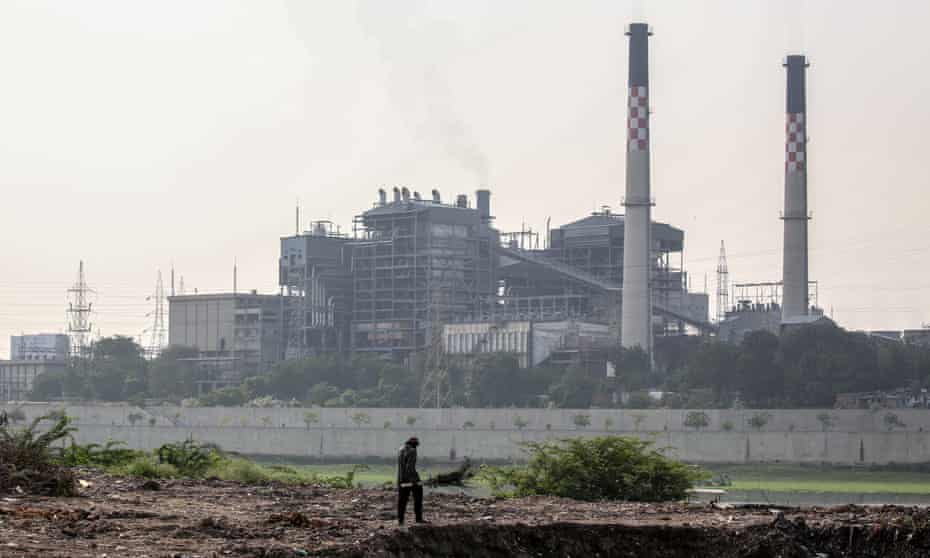Extract from The Guardian
Experts say country’s watering down of fossil fuel pledge reflected its lack of choices.

A coal power station at Sabarmati in Ahmedabad, India.
After pressure exerted by India and China, the wording of the final deal was watered down to a pledge to “phase down” rather than “phase out” coal. Alok Sharma, the president of Cop26, was on the brink of tears as he explained what had happened and the last-minute alteration brought sharp words of rebuke from the US and other nations.
While it was China that reportedly pushed hard for a softening of the language over coal in the final negotiations, it was India’s environment minister, Bhupender Yadav, who read out a new version of the Glasgow pact that used the watered-down commitment to a “phase down” of coal. Many speculated that it had fallen to India alone to announce the softening of the language over coal because it was seen as more palatable than an intervention by China.
India was not the first to push for a “phase down” of coal at Cop26. The US and China had already used the “phase down” language in the bilateral climate agreement signed on 10 November.
Among many climate experts, the consensus was that India was not the villain it was being portrayed as. Many said the criticism of India’s position highlights how the issues of climate injustice are still rife, with developing countries expected to meet the same commitments as wealthy developed countries, who have historically emitted the most and also have access to vast financial resources and alternatives such as natural gas.
“India setting a net zero target and agreeing to phase down of coal is surely a step forward from where it was in terms of national policies and commitments before arriving at Cop this year,” said Sunil Dahiya, an analyst at the Centre for Research on Energy and Clean Air in India.
This was the first time that any explicit commitment to phasing out any fossil fuel had been included in an international climate pact signed by India, which many said was still significant progress alongside India’s pledge to go net zero in 2070, announced on the opening day of Cop26 by the prime minister, Narendra Modi.
Dahiya said it was more important for India to commit to a date when it would hit peak coal, rather than being pressured into pledges to end the use of coal on the same timeline as the west. “If India formulates a detailed plan for coal phase-down and aggressive renewable energy deployment, they will be on track to diminishing coal capacity and consumption,” he said.
India has made huge strides in expanding renewables, but it still relies on coal for 70% of its energy and there is still no clear pathway for how the country can phase out coal entirely without the Indian people and economy paying a heavy price. Over the next 20 years, India’s energy demand is expected to grow faster than any other country as it grows, develops, industrialises and urbanises. Meanwhile, access to uninterrupted electricity is still a pipedream in many rural areas.

Renewables are growing rapidly but currently only account for 18% of electricity generation. Solar, while cheaper than fossil fuels, is intermittent and battery storage remains expensive. Green hydrogen is still at least a decade away from being feasible for India.
Ulka Kelkar, the director of climate at the World Resources Institute in India, said: “India’s intervention reflects its lack of choices – the country does not have significant oil and gas reserves and spends more than $100bn (£75bn) each year to import these, and nuclear power accounts for less than 2% of its electricity capacity.”
Brandon Wu, the director of policy and campaigns at ActionAid, was highly critical of those who had vilified India for the phrasing of the agreement. Wu, like others, pointed out that the agreement had only targeted coal while avoiding mention of other fossil fuels such as natural gas and oil, which are used in abundance by the US and European countries.
The US move away from coal was matched almost one to one by an uptake in the use of natural gas, which is a cheap domestically available resource in the country. While natural gas is less polluting than coal, it is still a fossil fuel and is highly problematic for the climate.
Wu described India’s intervention as a “reasonable response” and added: “By focusing only on coal and not including oil and gas, this text would disproportionately impact certain developing countries like China and India. India said in negotiations that all fossil fuels must be phased down, in an equitable manner.”
Rahul Tongia, a senior fellow at the Centre for Social and Economic Progress, said the concern for countries like India was that by committing to a phase out of coal, they would be expected to do it on the same timeline as countries in the west.
“But if all countries are doing is shifting away from coal because they happen to have a supply of natural gas, that’s very asymmetrical and doesn’t help the environment enough,” he said.
At Cop26, Tongia described coal as “low-hanging fruit” that was easy to seize on because of its filthy reputation, and that more graded and nuanced targets for all fossil fuels were necessary. “Whether it’s ‘phase out’ or ‘phase down’, both are virtue signalling,” he said. “I’m much more interested in short-term, boots-on-the-ground action.”
No comments:
Post a Comment